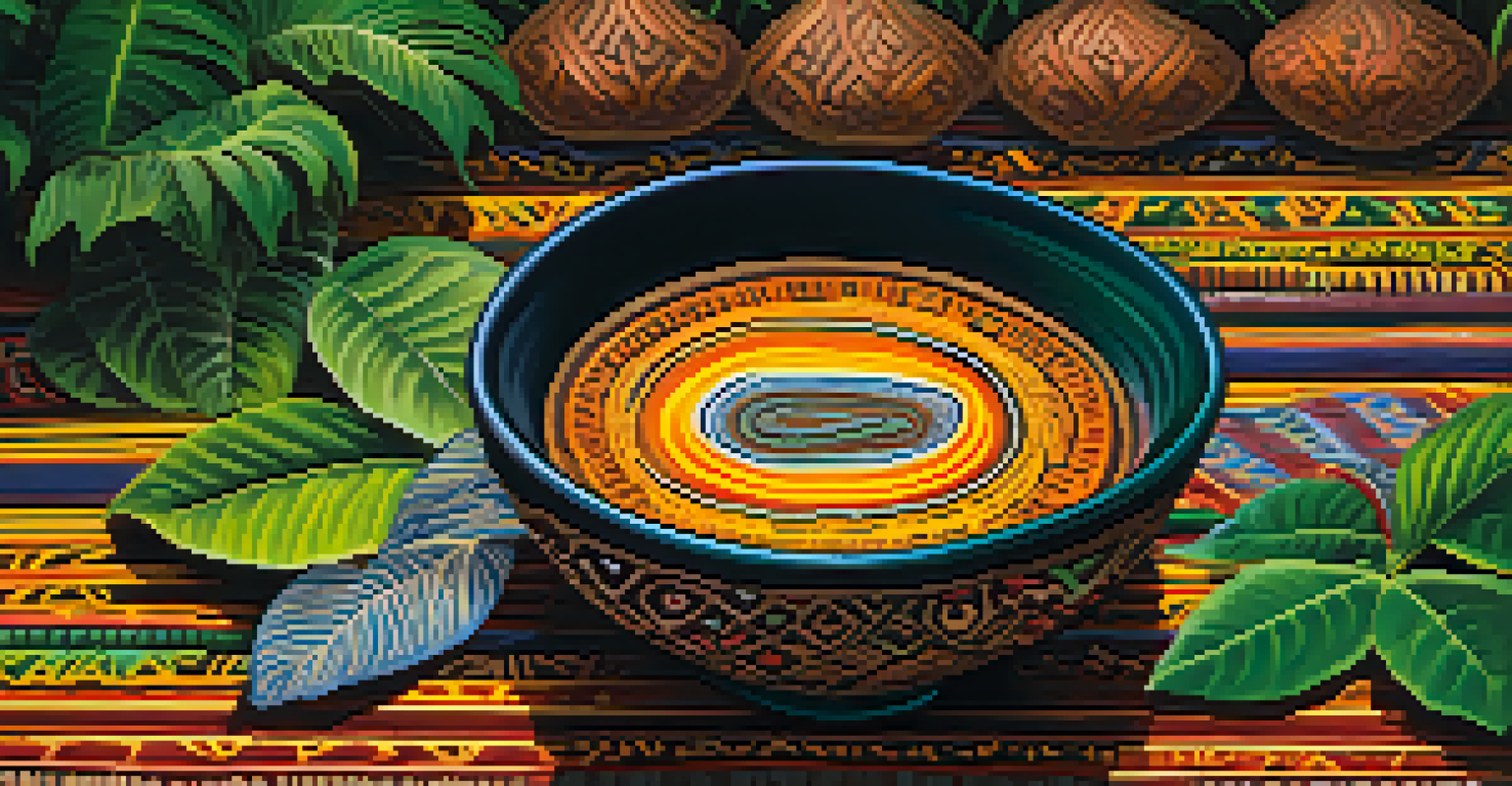Shamanism and Hallucinogens: A Historical Perspective

Understanding Shamanism: A Spiritual Practice
Shamanism is an ancient spiritual practice that has existed in various cultures around the globe. At its core, it involves a shaman, or spiritual healer, who connects with the spirit world to bring guidance and healing to their community. Often, this connection is facilitated through rituals, drumming, and sometimes the use of hallucinogenic substances.
The shaman is the one who can see beyond the veil of ordinary reality and bring back the wisdom of the spirit world.
The role of the shaman is not just limited to healing; they also serve as mediators between the physical and spiritual realms. This dual role allows them to address not only physical ailments but also emotional and spiritual disturbances. Their practices are deeply rooted in the cultural and historical context of the communities they serve.
Shamanism emphasizes the interconnectedness of all life, and practitioners often believe that spirits reside in nature, animals, and even in the elements. This holistic view encourages a deep respect for the environment and the life within it, which is a key aspect of shamanistic traditions.
Hallucinogens: Tools for Spiritual Exploration
Hallucinogens, or psychedelic substances, have been used for centuries in various cultures as tools for spiritual exploration. These substances can alter perception, mood, and cognitive processes, allowing individuals to experience altered states of consciousness. In shamanistic practices, these altered states are often sought to connect with spirits or gain insights into the self.

Common hallucinogens used in shamanistic practices include ayahuasca, peyote, and psilocybin mushrooms. Each of these substances has a rich history and is often tied to specific cultural rituals. For example, ayahuasca, a brew made from Amazonian plants, is traditionally used in ceremonies led by shamans to facilitate healing and spiritual awakening.
Shamanism's Spiritual Role
Shamanism involves spiritual healers connecting with the spirit world to provide guidance and healing to their communities.
The experience induced by hallucinogens can lead to profound insights and a sense of unity with the universe. Many individuals report experiencing vivid imagery, a feeling of transcendence, and even encounters with spiritual entities during their journeys. This capacity to connect with deeper aspects of consciousness makes hallucinogens a significant element in shamanistic practices.
Historical Roots of Shamanism and Psychedelics
The historical relationship between shamanism and hallucinogens can be traced back thousands of years. Archaeological evidence suggests that early humans used various plants and fungi for their psychoactive properties in spiritual rituals. These practices were not isolated; many ancient cultures around the world have documented the use of hallucinogens in their spiritual traditions.
Psychedelics can help us remember what we have forgotten; the connection to nature and spirit.
For instance, cave paintings in regions such as Europe and Australia depict figures believed to be shamans engaged in rituals that may involve the use of hallucinogens. These images provide fascinating insights into the spiritual beliefs and practices of our ancestors, highlighting the significance of altered states in their connection to the divine.
Moreover, texts from ancient civilizations like the Greeks and Egyptians also reference the use of mind-altering substances in religious ceremonies. This suggests that the use of hallucinogens for spiritual exploration is a universal phenomenon, transcending geographical and cultural boundaries.
Cultural Significance of Hallucinogens in Shamanism
In shamanistic cultures, hallucinogens are often seen as sacred gifts from the earth, used with reverence and respect. The consumption of these substances is usually accompanied by rituals that prepare the mind and body for the experience. This ceremonial context is vital, as it sets the stage for a safe and meaningful exploration of consciousness.
Furthermore, the cultural significance of hallucinogens extends beyond individual experiences; they also play a crucial role in community bonding. Rituals that involve hallucinogens often bring people together, fostering a sense of unity and shared purpose. This collective experience can strengthen social ties and deepen the community's spiritual beliefs.
Psychedelics in Healing Practices
Hallucinogens are used in shamanistic rituals to facilitate altered states of consciousness for spiritual exploration and healing.
Additionally, the use of hallucinogens in shamanism is often linked to ancestral wisdom. Many shamans report that their insights during altered states come from a lineage of spiritual knowledge passed down through generations. This connection to ancestry adds another layer of significance to the use of hallucinogens in these practices.
Modern Interest in Shamanism and Psychedelics
In recent years, there has been a resurgence of interest in shamanism and psychedelic substances, particularly in Western societies. This renewed fascination is often driven by a desire for holistic healing and personal growth. Many individuals are seeking alternative methods to address mental health issues, and the therapeutic potential of psychedelics is gaining attention.
Research on psychedelics is expanding, with studies showing promising results for treating conditions such as depression, anxiety, and PTSD. This scientific interest parallels the traditional uses of these substances in shamanistic practices, where they are employed to heal emotional and psychological wounds. The blending of ancient wisdom with modern science presents exciting possibilities for both personal and collective healing.
However, this modern interest also raises important questions about cultural appropriation and ethical use. As Western cultures adopt shamanistic practices, it is crucial to approach these traditions with respect and understanding. Ensuring that indigenous communities are honored and their practices are not exploited is essential for a responsible engagement with shamanism and psychedelics.
Challenges and Misconceptions Surrounding Shamanism
Despite the growing interest in shamanism and hallucinogens, there are many misconceptions and challenges associated with these practices. One common misunderstanding is that shamanism is a monolithic tradition, when in reality, it encompasses a diverse range of beliefs and practices that vary widely across cultures. Each tradition has its unique rituals, beliefs, and methods of connecting with the spiritual realm.
Another challenge is the commercialization of shamanism and psychedelics, particularly in Western contexts. As the popularity of psychedelic retreats and workshops grows, there is a risk of diluting the spiritual significance of these practices. This commercialization can lead to a lack of genuine understanding and respect for the cultural origins of shamanism.
Modern Interest and Ethical Concerns
The resurgence of shamanism and psychedelics in Western societies raises questions about cultural appropriation and the ethical use of these practices.
Additionally, there are ethical concerns regarding the use of hallucinogens outside their traditional contexts. It's essential to approach these substances with caution and an understanding of their potential risks. Engaging with shamanism should be done thoughtfully, ensuring that cultural sensitivity and respect for indigenous practices are upheld.
The Future of Shamanism and Hallucinogens
As society continues to explore the intersections of shamanism and psychedelics, the future holds exciting possibilities. The integration of traditional practices with modern therapeutic approaches could lead to a broader acceptance of psychedelics as legitimate tools for healing and personal growth. This shift could foster a deeper understanding of the spiritual dimensions of mental health.
Moreover, as more people seek authentic experiences, there may be a growing demand for genuine shamanic practices. This could encourage a revival of traditional knowledge and a renewed focus on the importance of cultural heritage. Communities may find strength in reclaiming their practices and sharing their wisdom with the world.

Ultimately, the future of shamanism and hallucinogens will depend on our ability to respect and honor the traditions that have shaped these practices for centuries. By fostering open dialogue, cultural exchange, and ethical engagement, we can ensure that shamanism continues to thrive in a way that honors its rich history and profound spiritual significance.